Ervin Løffler stands as a prominent figure in contemporary Norwegian sculpture, his biography carrying an air of mystique despite its known contours. Following his arrival in Norway as a refugee from Hungary post-World War II, Løffler marked his debut as an artist with a bust of his wife showcased at the esteemed annual exhibition, Høstutstillingen, in 1947. Prior to this, he had pursued studies at a drawing school in Budapest during the war and subsequently served as an assistant for the Norwegian sculpture association, Norske Billedhuggere, until 1960. Immersed in the milieu of artists such as Gunnar Janson, Emil Lie, and Ørnulf Bast during his tenure as an assistant, Løffler embraced a classical figurative style.
Following a hiatus from sculpture between 1959 and 1969, Løffler returned to the forefront with renewed vigor, now embracing abstraction in his artistic expression. While his work shares formal similarities with the sculptures of Henry Moore and Hans Arp, Løffler's pieces possess a distinctiveness in both execution and conceptual underpinnings.
Ervin Løffler (1922 – 2012) may not have always been at the forefront of discussions surrounding Norwegian abstract sculpture, a position often occupied by Arnold Haukeland (1920 – 1983) and, to some extent, Aase Texmon Rygh (1925 – 2019). This could be attributed to the fact that, despite being of the same generation as his counterparts, Løffler introduced abstract sculptures at a later stage. In juxtaposition with the works of Haukeland and Rygh, Løffler emerges as a distinct and independent figure. His art features organic and enclosed forms, drawing essential inspiration from human and animal bodies. In contrast, Rygh's oeuvre stems from geometric models, while Haukeland's sculptures embody an expressive and dynamic form.
Løffler was awarded a Hungarian state scholarship from 1970 to 1973, enabling him to pursue further studies in Budapest. In 1975, he received a three-year work scholarship from the Norwegian State, followed by the Norwegian State's guaranteed income in 1978. These grants provided him with the opportunity to scale up his small models into larger formats and engage in periods of work at workshops in Pietrasanta, Tuscany. Renowned for his mastery of marble as a material, few Norwegian artists have demonstrated Løffler's level of proficiency. The pinnacle of his career came with an extensive exhibition at the prestigious Norwegian institution Kunstnernes Hus in 1977.
Several of Ervin Løffler's abstract sculptures have found their way into public spaces, becoming familiar sights for many as they go about their daily routines. Notably, his sculpture "Full Form" in the promenade hall of the National Theatre station stands out as one of the country's most popular sculptures among children. This popularity is not accidental. Løffler's sculptures exude organic and harmonious forms, inviting viewers with their placement on low plinths rather than looming imposingly, as is often the case with public sculptures.
A humanistic spirit pervades Løffler's work. Even in his most dynamic pieces, such as those depicting horses and riders, there is a sense of restrained energy. This human aspect is evident in sculptures where he merges the human figure with musical instruments, as seen in his series exploring the theme of man and cello. His classical schooling in sculpture ideals, prevalent among Norwegian sculptors in the 1940s and 1950s, is apparent. The prevailing ideal of harmonious formal progression informs Løffler's work, where individual forms are intricately connected, creating a cohesive and uniting ornament as viewers navigate around his sculptures.
One of the most striking features of Løffler's sculptures is his mastery in creating form through negative space, drawing the surrounding environment into an active dialogue with the artwork. Alongside his adept handling of form, Løffler's art showcases a solid craftsmanship. Whether cast in bronze or carved in stone, his works exhibit technical mastery, reflecting the meticulous attention to detail characteristic of a discerning artist. Løffler's sculptures resonate across generations and artistic mediums, highlighting their enduring relevance and versatility in contemporary art discourse.

